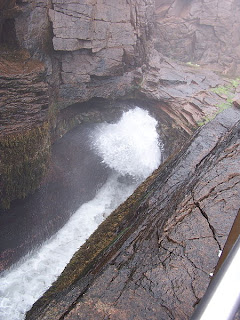Let’s talk
about colours. People of all ages, be it the youngest or the oldest, everyone
loves a bright world. What would our world be without these various colours?
Ever thought of a tree that could change colour every season? It’s time you
entered the colourful state of Vermont in the USA.
 |
| Moss-Glen Fall |
The people,
water, mountains, land, forests and the famous seasons all combine to make
Vermont, a truly unique destination. Vermont’s natural heritage covers a lot of
areas. The abundance of natural beauty is made even more remarkable by the way
it converges: seemingly endless emerald fields lead to forests crowned by
magnificent mountains. Then there’s the water. A little known fact is that
Vermont is home to over 400 lakes and ponds, plus hundreds of streams. The
state is also the abode of Lake Champlain, the sixth-largest body of water in
the US. If you are seeking sun and sand in one place, where water can also be a
part of the picturesque – Vermont is the right place. The Moss-Glen falls in
the Green Mountains is one such attraction.
 |
| A colourful trail in Green Mountain |
Woods,
mountains and ice-cream – Vermont has just about everything to lure a traveller.
During the fall season, the state’s Green Mountains are known for some of the
most colourful foliage in the world. The state makes up for the absence of
‘attractions’ with the profusion of galleries, craft shops, maple syrup farms
and cheese-making shops that spring from every curve in the road. The mountains
where you will find the world famous fall foliage, the sweetest maple syrup,
historic yet lively downtowns and the most snow on the east coast have more to
offer. The local foods produced by local farmers and sold in the farmer’s
market all year round, the ultra pampering spas and resorts, endless
recreational and relaxing opportunities, significant historic sites and
pristine parks, the classic inns…the treasures of Vermont go on and on.
 |
| The landscape in Vermont |
In Vermont,
one thing is beautifully certain; the seasons will change. And with that
change, so does the landscape, the weather, the water, the activities and the
way of life. With every season come new opportunities to explore the world
around you in Vermont.
Though you
could spend hours simply admiring in the scenery, it is even more rewarding to
become a part of it. It could be long walks, hike a mountain trail or stroll
through a covered bridge in one of the villages. Whatever the day offers, the
night is sure to deliver peaceful sleep, whether you choose to camp under the
twinkling stars or under a comforter at a bed-n-breakfast. But, the best way to
explore Vermont is to get in a car and hit the roads, stopping at country
stores that sell different kinds of maple syrup, cheese etc.
The
geographical variety of the state means there is a wide variation in colour in
different areas at the same time. At anytime you can find good colour just by
driving north or south or heading up the mountains or down the valley,
depending on where you are. You should know that trying to predict when the
colour will be absolutely perfect is a loser’s game.
 |
| The Foliage |
Frankly, it
is not necessary. Instead of chasing the elusive ‘peak’ of foliage is a way
that you might ruin the trip. It takes away from all other things that make a
fall trip in Vermont magical: harvest festivals, farm-stands, fresh-pressed
apple cider and sunny days of fresh mountain air.
To enjoy
the world’s most beautiful fall foliage and to escape from the hustle and bustle of the city, here’s a chance to plan a trip to Vermont, one of the most colourful
states on the east coast of the USA.
-
Srividya
Iyer



